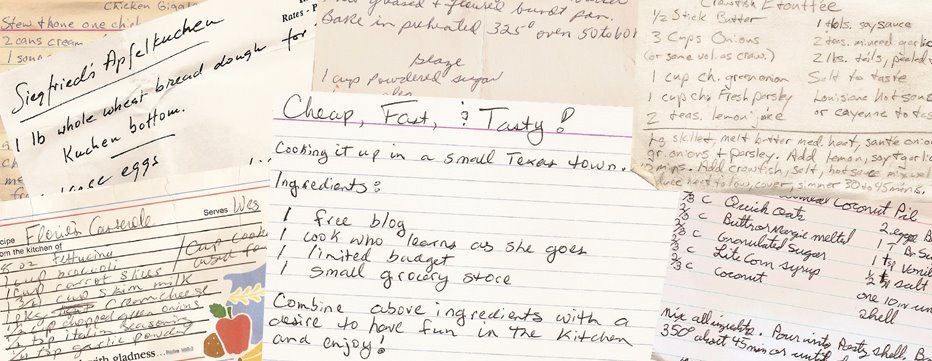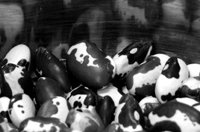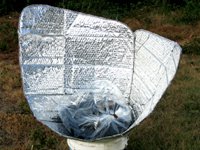Update: Heinz sells raw vinegar now, yay! I picked up some today at Walmart to start some fresh homemade vinegar.
Really good homemade vinegar can take your cooking from blah to BAM (jeez, I said "bam")! But fancy store-bought vinegars are so expensive. If you drink wine anyway, there's no reason not to make your own wine vinegar. If you drink beer, the same applies. I don't drink, but I buy wine and beer specifically to make vinegar.
Homemade vinegar requires virtually no work, although there is a bit of odor involved. I consider it to be a great smell, like baking bread. Although I do keep my vinegar jugs next to the air purifier.
To make your own vinegar all you need is some leftover wine (not port, lower alcohol content wines are better) or a warm beer, a few tablespoons of Bragg Apple Cider Vinegar, water, and a very clean glass jar. There are other ways to make vinegar, this is just one way. Vinegar making instructions vary from resource to resource.
My vinegars sitting on the kitchen counter, protected from the light and set near the air purifier. Vinegar needs to breathe, no tight fitting lids here.
A small bottle of Bragg ACV (apple cider vinegar) is all you need to start up several batches of vinegar. You can buy it at most health food stores or gourmet type grocery stores. The reason it has to be Bragg is because you need LIVE vinegar culture, which is a kind of bacteria. This bacteria is known as Mother of Vinegar. Bragg doesn't pasteurize their product and so it's still alive. If you can't get Bragg, you can still make vinegar--but you either need to purchase the bacteria from somewhere or get the mother from someone or you have to wait and hope that the right bacteria will find its way into your alcohol--the bacteria is all around us in the air and it's quite likely you'll have a spontaneous mother grow in your wine. If it doesn't, your jar of wine or beer will just spoil. It will also take a lot longer to get started without the Mother.

Mother of vinegar from the red wine batch.
To begin this process, dilute one cup of wine (if using beer, don't dilute) with one cup of water and pour into your very very clean glass jar (starting out with a quart jar is fine, but you'll be moving up to a gallon jar within a few short months) and add three or four tablespoons of Bragg ACV. Cover with a thin cloth or paper towel and set it somewhere dark and not too cold. To keep insects out, use a rubberband or string to keep the cloth tight around the jar opening. Remember not to use port or a wine that contains a very high alcohol content. Anything from 5% to 15% has been working fine for my use. I usually end up with wines that are around 9 to 14%.
Red Wine Vinegar
At first, I didn't have a dark place to put my vinegars so I just covered them with a dark pillow case. They live in some old butter churns now (well, the red and the white do) so I don't have to worry about the light. In two weeks, add another cup of the same kind of alchol. Don't mix red wine with white wine, and don't mix wine with beer. Although if you need or want to use your white wine Mother to start your red wine vinegar or to start your beer vinegar, go for it. But if you put a red Mother in your white wine or beer vinegars, it's really going to make them look funny.
Every two weeks add another cup of alcohol, undiluted. Eventually you will see something forming on top of the liquid that may look at first to be mold. But it will thicken. And if left undisturbed long enough, it will sink. This is the Mother. Seeing her is a VERY good sign. By the way, unless you have a very hardy mother, your mother is probably going to sink every time you feed your vinegar. Don't worry abou this. She'll also sink on her own for no apparent reason, don't worry about it.
I don't know what other people get, but in my vinegars the red wine mother is very thick and rubbery, the white wine vinegar is kind of delicate and doesn't get very thick, the beer vinegar is thinner than paper and it only thickened for me once, since then it's been very thin. I haven't quite figured out why but added a little extra Bragg ACV to it this week and am curious to see if it makes my mother healthier. For no reason at all I equate a healthy looking mother with a better batch of vinegar. But regardless of how the Mothers look, my vinegar is vinegar and so I know all is well.
But I digress. Once you have a mother, you can rest assured that you have performed a miracle by turning wine into vinegar. Pat yourself on the back. Feed your vinegar batch every few weeks or so. How do you know when it's done? The smell should give it away, but if not, just taste it. You'll know instantly whether or not you have vinegar. You can also buy acid test strips (you might try finding them at your local pharmacy or a brewer supply store) to test the acidity of your vinegar. If, for some reason, your vinegar stops producing a mother, check to make sure it hasn't spoiled and then just add a few more tablespoons of Bragg. It will get itself going again.
Maintaining your vinegar:
If you are just feeding it leftover wine, pour in what you have when you have it and don't worry about measuring. If not, just add a cup of alcohol every two weeks or so. When you have at least a gallon of the stuff going, feel free to "up the dose" when you feed it.
And you ARE feeding it. The Mother bacteria is eating the sugar in the alcohol and the end result is vinegar.
Every couple of months I remove the vinegar from the jars and wash the jars/jugs thoroughly. I strain the vinegar through a sieve and put it back in its container, and then I throw the most recent mother from each batch back into their respective jugs. I don't know if it's right to do this occasional cleaning, it's just what I do and since I am still producing vinegar--it seems as if it isn't hurting anything. I don't worry about cleaning the ceramic jugs as much because I can't see inside them. Vinegar will kill anything scary in them, so there's no worry about spoilage as long as it's still vinegar. But in the clear jug I use, I want it to look nice, which is why I clean it every couple of months. I don't want someone to be too afraid to eat my coooking because they caught site of my gallon jug of beer vinegar and assume that what looks gross must certainly be gross.
You don't HAVE to put a mother back in the batch, but I always do because I noticed that if I don't, it takes a lot longer for a new mother to form and I like the validation of seeing her to know that my vinegar is vinaegaring properly. I always put the youngest Mother back in the jar and dispose of older Mothers.
For cooking, just remove however much vinegar you need for the recipe you are preparing and pour it through a sieve to remove any large floating bits of Mom. You don't need to pasteurize your vinegar for salad dressing or sauces unless you intend to store them for an extended period. There is nothing at all harmful about drinking "living" vinegar and, in fact, some people believe that the live bacteria is very healthy for your body.
The red wine vinegar mother floating in her jug before I removed her to take a photo.
For gifting, you may want to pasteurize the vinegar. I do it by bringing the vinegar to a boil and then letting it simmer for about ten minutes. But there are differences of opinion on how to do it. Some sources say it should be kept at 170 degrees for ten minutes, others say 155 degrees for 30 minutes. I'm far too lazy to use a thermometer on my vinegar. So far, I've never had a batch come back to life after the way I pasteurize it. But maybe I've just been lucky.

For gifting, you may want to pasteurize the vinegar. I do it by bringing the vinegar to a boil and then letting it simmer for about ten minutes. But there are differences of opinion on how to do it. Some sources say it should be kept at 170 degrees for ten minutes, others say 155 degrees for 30 minutes. I'm far too lazy to use a thermometer on my vinegar. So far, I've never had a batch come back to life after the way I pasteurize it. But maybe I've just been lucky.
Beer vinegar sitting in the window for light so I could take a clear shot. Down to half a gallon because I used a bunch of it to make spicy, pickled eggs.
Once pasteurized, you can strain it through a coffee filter so that it looks more clear and attractive. For pickling, you can use the same process. However, if you are doing some serious pickling, it may be wise to get those test strips to make sure there is a high enough acid level in your vinegar to properly preserve what you are canning. For minor pickling, such as putting peppers and vinegar in a bottle to infuse for use as pepper sauce, there's no need to worry about the acid level. I would, however, pastuerize it for this kind of pickling. Some people prefer to combine pasteurized apple cider vinegar and their homemade vinegar for pickling to insure a high enough acid level.

Once pasteurized, you can strain it through a coffee filter so that it looks more clear and attractive. For pickling, you can use the same process. However, if you are doing some serious pickling, it may be wise to get those test strips to make sure there is a high enough acid level in your vinegar to properly preserve what you are canning. For minor pickling, such as putting peppers and vinegar in a bottle to infuse for use as pepper sauce, there's no need to worry about the acid level. I would, however, pastuerize it for this kind of pickling. Some people prefer to combine pasteurized apple cider vinegar and their homemade vinegar for pickling to insure a high enough acid level.
The white wine vinegar-- the mother was resting peacefully on top of the vinegar (as she should) until I moved the jug. Now she looks like a dead jelly fish or something floating under the surface.
Vinegar making links and resources:Word to Your Mother
Vinegar Man
Wine Tasting Guide
Susun Weed -- thoughts on vinegar and healing












5 comments:
Awesome! I just started my first batch yesterday and look forward to the results! Thank you for sharing!
Hi! I am making vinegar for the first time -- apple cider vinegar (1 gal cider, 1 qt Bragg's) and some fruit scrap vinegar also. They are both cooking right along and the cider vinegar in particular has a lovely mother. I'm wondering now, what do I do with her when the vinegar is ready? I won't need another batch right away, so do you know if there is there some way I can preserve her? In the fridge in some water, maybe? Will she starve? :(
Have you ever used a cider mother for a red wine starter? Does mixing it up affect the flavor of the resulting vinegar, or just the color?
Yay, fermentation!
Found EXACTLY what I was looking for by visiting this sight ! Thanks!! I was reluctant to purchase a "mother" & now glad I didn't. My vinegars have momma's all over my counter. I am hoping friends will want some since I went alittle over board & made way too much. :D
As y'all can tell, I haven't been around much. But I'm delighted to see people making their own vinegar!
I am sure it's far too late to answer your question, Lauren. I never did find out how to preserved the mothers, I just kept Bragg's on hand. I wish I knew how they kept theirs alive in those bottles. Since the mothers aren't whole in a Bragg bottle, perhaps they just make sure the live bacteria is in there and don't pasteurize the product before bottling? I really don't know.
I've only ever used white wine, which did not do well, and red wine for vinegar. No idea how mixing mothers from one vinegar base into another would work, all you can do is try.
Which begs the question, what did you try? What worked?
I feel you, Linda. I hated throwing mothers out but I ended having to. No one was interested.
Pam, how did your first batch turn out?
Post a Comment